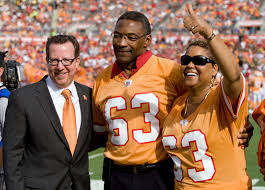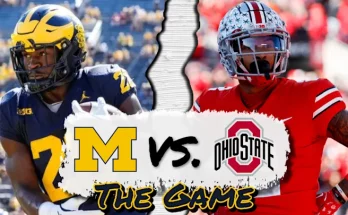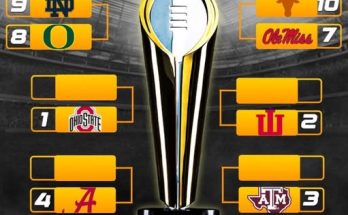In a moment that reverberates far beyond the gridiron, TIME Magazine has posthumously named Lee Roy Selmon—Oklahoma Sooners legend, NFL Hall of Famer, and tireless community advocate—to its prestigious TIME 100 Most Influential in Sports list. It’s a recognition not just of athletic greatness, but of a life lived with integrity, leadership, and service. Over a decade after his passing, Selmon’s name continues to carry weight—not because of statistics alone, but because of how he carried himself during and after his iconic football career. His inclusion in this elite group reminds the world that influence in sports transcends trophies; it lies in how lives are impacted, communities are uplifted, and a standard of decency is maintained even under the brightest lights.
For many who have followed the storied history of Oklahoma football, the name Lee Roy Selmon is not just revered; it is almost sacred. A member of the legendary Selmon brothers, Lee Roy was the youngest, yet often regarded as the most dominant on the field. His collegiate years at the University of Oklahoma under head coach Barry Switzer saw him rise to unprecedented levels of excellence. Selmon was the cornerstone of one of the most feared defensive units in college football history, helping lead the Sooners to back-to-back national championships in 1974 and 1975. During this period, Oklahoma posted a combined record of 32-1-1, with Selmon terrorizing quarterbacks and dismantling offensive lines with frightening consistency. He would go on to win the 1975 Outland Trophy and the Lombardi Award, cementing his place as the nation’s most formidable defensive lineman.
Selmon’s impact extended far beyond Norman, Oklahoma. In 1976, he was the first overall pick in the NFL Draft, selected by the expansion Tampa Bay Buccaneers. While that franchise was still in its infancy and struggled mightily in its early seasons, Selmon immediately provided both legitimacy and leadership. His arrival symbolized hope, not just for wins, but for building a culture around discipline, hard work, and honor. On the field, he was everything a franchise could dream of—quick off the line, powerful at the point of attack, and relentless in pursuit. He was a six-time Pro Bowler, a Defensive Player of the Year, and in 1995, he was inducted into the Pro Football Hall of Fame—the first Buccaneer to ever receive that honor.
But football was only one part of the Selmon story. What separates Lee Roy Selmon, and what makes this TIME 100 recognition so richly deserved, was who he was outside the lines. He didn’t just retire and fade into obscurity. He remained in Tampa, building deep and meaningful ties with the community that embraced him. His second act in life was equally impactful. Selmon worked in various leadership capacities at the University of South Florida, where he played a pivotal role in launching the school’s football program. As the program’s first athletic director, he laid a strong foundation of ethics, academics, and competitiveness that continue to guide the institution today.
It was during this time that many who had never watched him play began to realize the depth of his character. Selmon wasn’t just a figurehead; he was a mentor, a leader, and a humble presence who made time for everyone. Whether it was helping raise funds for student scholarships, organizing outreach programs, or quietly supporting countless civic initiatives, his service record read like a blueprint for community engagement. In Tampa, a city known for its many sports heroes, Selmon remains a singular figure. He was a civic icon, once dubbed “Tampa’s Gentle Giant,” a moniker that captured both his imposing athletic presence and his serene, generous spirit.
His death in 2011 at the age of 56 from a stroke sent shockwaves through both the sports and civic communities. The grief was immediate, the tributes heartfelt, and the loss incalculable. And yet, his legacy continued to expand. The city of Tampa renamed a major expressway in his honor—the Lee Roy Selmon Expressway—a rare gesture, typically reserved for former governors or national leaders, not athletes. His restaurant chain, “Lee Roy Selmon’s,” became more than a culinary destination—it became a monument to his warmth and generosity. And now, with his induction into TIME’s list of the most influential figures in the history of sports, his name is once again being rightfully elevated to the global stage.
TIME’s editorial board, in its announcement, praised Selmon not merely for his “extraordinary physical gifts,” but for his “unyielding commitment to humanity.” In an age when athletic greatness is often tied to endorsement deals, media personas, and viral moments, Lee Roy Selmon represents an enduring archetype—the quiet giant who lets his values do the talking. He didn’t need to be the loudest voice in the room because he lived in a way that echoed louder than any speech could. His influence didn’t come from brash declarations but from a legacy of respect earned from every teammate, coach, opponent, and fan who crossed his path.
The honor also resonates deeply in the Oklahoma football community. Barry Switzer, upon hearing the news, described it as “one of the proudest moments in Oklahoma history.” For those who wore the crimson and cream, Selmon was always a gold standard. He wasn’t just another great Sooner; he was the Sooner, the kind of player and man who defined what the program stood for. His rise from Eufaula, Oklahoma—a small town with humble roots—into national prominence inspired generations of players to believe that greatness could be achieved through grit, humility, and faith.
Even more profoundly, Selmon’s story has become an essential part of African-American sports history. Coming of age in the South during the Civil Rights Movement, he was a beacon of progress, an example of how talent and integrity could not be ignored even in systems that often resisted change. He shattered barriers, not with anger but with excellence. And in doing so, he made life easier for countless young Black athletes who would follow in his footsteps. The TIME 100 recognition is also a celebration of that long-arc journey toward equity, representation, and the quiet revolutionaries like Selmon who advanced it every day by simply being their best, most principled selves.
Perhaps what makes Lee Roy Selmon so compelling—and so right for this list—is the seamless way he bridged sports and society. Many athletes inspire, but few transform. Fewer still do so in such a consistently humble manner. He did not chase the spotlight, but it found him. He didn’t chase accolades, but they arrived. And now, more than a decade after his passing, his light hasn’t dimmed—it’s intensified. Generations of athletes continue to be inspired by his story. Coaches invoke his name when trying to define the ideal teammate. Broadcasters use him as the gold standard of off-the-field conduct. And communities, both in Oklahoma and Tampa, continue to feel his presence in tangible and emotional ways.



